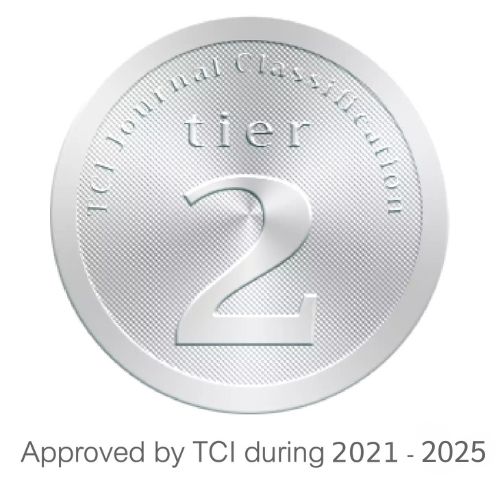ความตระหนัก ความคาดหวัง และการรับรู้ของนักท่องเที่ยวต่างชาติ ที่มีต่อภัยเสี่ยง และมาตรการความปลอดภัยแหล่งท่องเที่ยว
The Analysis of International Tourists’ Awareness, Expectation, and Perception toward Incident Risks and Destination Safety Measures
Keywords:
ภัยเสี่ยง, มาตรการความปลอดภัยแหล่งท่องเที่ยว, ความปลอดภัยแหล่งท่องเที่ยวAbstract
การศึกษาครั้งนี้มีวัตถุประสงค์เพื่อค้นหาปัจจัยด้านความปลอดภัยของแหล่งเที่ยวที่สำ คัญ เพื่อส่งเสริมความเชื่อมั่นด้านความปลอดภัยของนักท่องเที่ยวต่างชาติในประเทศไทย ด้วยศึกษาความ ตระหนักและการรับรู้ถึงภัยเสี่ยง ความคาดหวังและการรับรู้ที่มีต่อมาตรการความปลอดภัยของแหล่ง ท่องเที่ยว รวมถึงการสร้างปัจจัยด้านความปลอดภัยแหล่งท่องเที่ยวที่สำคัญ โดยการศึกษาอาศัย การวิจัยเชิงปริมาณ กลุ่มประชากรในการวิจัยได้แก่นักท่องเที่ยวต่างชาติจาก 7 ภูมิภาค โดยใช้ แบบสอบถามเป็นเครื่องมือหลักในการเก็บรวบรวมข้อมูลจำ นวน 492 ตัวอย่าง และวิเคราะห์ผลด้วย สถิติเชิงพรรณนา รวมทั้งการวิเคราะห์ปัจจัยเชิงสำ รวจตามวัตถุประสงค์ที่ตั้งไว้ ผลการศึกษาพบว่า ระดับความตระหนักและการรับรู้ต่อภัยเสี่ยงในแหล่งท่องเที่ยวอยู่ในระดับค่อนข้างต่าและต ํ ่าตามลำ ํ ดับ โดยปัจจัยที่ควรเน้นความสำคัญคือด้านการคิดเงินเกินราคาของผู้ประกอบการด้านการท่องเที่ยว ในขณะที่ ระดับความคาดหวังและการรับรู้ต่อมาตรการความปลอดภัยของแหล่งท่องเที่ยวอยู่ในระดับปานกลาง และสูงตามลำดับ ผลการวิเคราะห์ปัจจัยเชิงสำ รวจ พบว่ามีเพียง 28 ปัจจัยที่สำคัญและถูกจัดกลุ่มเป็น 5 ตัวแปรองค์ประกอบ ได้แก่ด้านสภาวะที่ไม่สามารถควบคุมได้ของแหล่งท่องเที่ยว ด้านมาตรการ การรองรับของแหล่งท่องเที่ยว ด้านมาตรการการป้องกันของแหล่งท่องเที่ยว ด้านสภาวะทางพลเมือง และการเมืองของแหล่งท่องเที่ยวและด้านอาชญากรรมของแหล่งท่องเที่ยว โดยมีค่าร้อยละความReferences
ABTA. (2015). Travel Trends Report 2014. London: ABTA Ltd.
Albrechtsen, E. (2003). Security VS Safety. Trondheim: Department of Industrial Economics and Technology Management, Norwegian University of Science and Technology.
Ashton, A. S. (2009). Hotel Restaurant Co-Branding: the Relationship of Perceived Brand Fit, Perceived Risk and Perceived Value with Intention to Purchase.PhD thesis (Tourism). Queensland: Tourism School, University of Queensland.
Photocopy.Brotherton, B. (2015). Researching Hospitality and Tourism. London: Sage.
Cavlek, N. (2002). Tour Operators and Destination Safety. Annals of Tourism Research,29(2): 478-496.
Chieochankitkan, A. (2013). Developing Service Quality for Spa Establishments in the Active Beach Tourism Cluster. Ph.D. thesis (Integrated Tourism Management).Bangkok: National Institute of Development Administration. Photocopy.
Dwyer, L., Edwards, D., Mistilis, N., Roman, C., & Scott, N. (2009). Destination and Enterprise Management for a Tourism Future. Tourism Management, 30(1): 63-74.
Crotti, R., & Misrahi, T. (2015). The Travel & Tourism Competitiveness Report 2015.Geneva: the World Economic Forum.
Fakeye, P. C., & Crompton, J. L. (1991). Image Differences between Prospective, First-Time, and Repeat Visitors to the Lower Rio Grande Valley. Journal of Travel Research, 30(2): 10-16.
Gnoth, J. (1997). Tourism Motivation and Expectation Formation. Annals of Tourism Research, 24(2): 283-304.
Hair J, Anderson RE, Tatham RL, Black WC. (1995). Multivariate Data Analysis. 4th ed. New Jersey: Prentice-hall Inc.Howard, R. W. (2009). Risky Business? Asking Tourists What Hazards They Actually Encountered in Thailand. Tourism Management, 30(3): 359-365.
Kovari, I., & Zimányi, K. (2011). Safety and Security in the Age of Global Tourism APSTRACT: Applied Studies in Agribusiness and Commerce. AGRIMBA, 5(3-4):1-3.
Larsen, S. (2007). Aspects of a Psychology of the Tourist Experience. Scandinavian Journal of Hospitality and Tourism, 7(1): 7-18.
Lepp, A., & Gibson, H. (2003). Tourist Roles, Perceived Risk and International Tourism.Annals of Tourism Research, 30(3): 606-624.
Manning, T. (2004). Indicators of sustainable development for tourism destinations:A Guidebook. Madrid: World Tourism Organization.
Milman, A., & Pizam, A. (1995). The Role of Awareness and Familiarity with a Destination:The Central Florida Case. Journal of Travel Research, 33(3): 21-27.
Pizam, A., & Mansfeld, Y. (2006). Tourism, Security and Safety: From Theory to Practice.Oxford: Butterworth-Heinemann.
Reisinger, Y., & Mavondo, F. (2006). Cultural Differences in Travel Risk Perception. Journalof Travel & Tourism Marketing, 20(1): 13-31.
Rittichainuwat, B. N., & Chakraborty, G. (2009). Perceived Travel Risks Regarding Terrorismand Disease: the Case of Thailand. Tourism Management, 30(3): 410-418.
Robertson, D., Kean, I., & Moore, S. (2006). Tourism Risk Management: An AuthoritativeGuide to Managing Crises in Tourism. Singapore: Asia-Pacific EconomicCooperation (APEC).
Roehl, W. S., & Fesenmaier, D. R. (1992). Risk Perceptions and Pleasure Travel: an Exploratory Analysis. Journal of Travel Research, 30(4): 17-26.
Sönmez, S. F., & Graefe, A. R. (1998). Influence of Terrorism Risk on Foreign Tourism Decisions. Annals of Tourism Research, 25(1): 112-144.
Tabachnick BG, Fidell LS. (2007) Using Multivariate Statistics. Boston: Pearson EducationTribe, J., & Snaith, T. (1998). From SERVQUAL to HOLSAT: Holiday Satisfaction in Varadero, Cuba. Tourism Management, 19(1): 25-34.
Tsaur, S. H., Tzeng, G., & Wang, K. C. (1997). Evaluating Tourist Risks from Fuzzy Perspectives.Annals of Tourism Research, 24(4): 796-812.
UNWTO. (2015). Tourism Highlights 2015 Edition. Madrid: World Tourism Organization.William, Brett; Brown, Ted; & Onsman, Andrys. (2010). Exploratory Factor Analysis: A Five-Step Guide for Novices. Australian Journal of Paramedicine, 8(3): 1-12.








